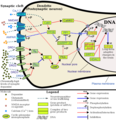Datei:Annotated ΔFosB.svg screenshot.png
aus Wikipedia, der freien Enzyklopädie
Zur Navigation springen
Zur Suche springen

Größe dieser Vorschau: 580 × 599 Pixel. Weitere Auflösungen: 232 × 240 Pixel | 464 × 480 Pixel | 743 × 768 Pixel | 1.200 × 1.240 Pixel
Originaldatei (1.200 × 1.240 Pixel, Dateigröße: 399 KB, MIME-Typ: image/png)
![]()
Diese Datei und die Informationen unter dem roten Trennstrich werden aus dem zentralen Medienarchiv Wikimedia Commons eingebunden.
Beschreibung
| BeschreibungAnnotated ΔFosB.svg screenshot.png |
English: This is a screenshot of the Wikitext-annotated variant of File:ΔFosB.svg as used in the English Wikipedia template en:Template:Psychostimulant addiction, without the notes in the top-right corner. For a description of what the diagram illustrates, follow the preceding link to the English Wikipedia template page. 
|
| Datum | 17 April 2015 (the SVG image revision was published on 21 July 2014) |
| Quelle | Eigenes Werk |
| Urheber | Joseph Mickel (Seppi333) |
| Genehmigung (Weiternutzung dieser Datei) |
Notice about new image licensing options: As of February 2020, this file has been multi-licensed to more broadly permit the reuse of this image within other media. The original licensing option was the CC-BY-SA-3.0 license. It is now available under all CC-BY-SA licenses as well as the more permissive CC-BY-4.0 license, which does not include the share-alike condition. |
| Andere Versionen | ■ File:ΔFosB.svg – unlabeled version |
| Related image files InfoField | ■ File:ΔFosB accumulation.svg – graphical illustration of how ΔFosB expression changes over time after drug exposure ■ File:TAAR1 Dopamine.svg – schematic illustration of how amphetamine induces the release of dopamine from dopaminergic axon terminals into the synapse via TAAR1 binding and collapsing the vesicular pH-gradient through VMAT2 |
Lizenz
| This item is available under multiple licenses. When using it, you can choose which of the following licenses to use. Please make sure you respect the license terms of the license you choose, including any requirements and restrictions (such as attribution requirements and restrictions on commercial use). |

|
Helpful note: Creative Commons Attribution 4.0 International (the first licensing option below) is the most permissive license for republishing this image. None of the licensing options below require you to ask me for permission to republish this file (you already have it) or even notify me before doing so; I'm always happy to learn when/how others reuse media I've created though. |
Ich, der Urheberrechtsinhaber dieses Werkes, veröffentliche es hiermit unter der folgenden Lizenz:
Diese Datei ist lizenziert unter der Creative-Commons-Lizenz „Namensnennung 4.0 international“.
Namensnennung: you may credit either User:Seppi333 or "Joseph Mickel" in the attribution line.
- Dieses Werk darf von dir
- verbreitet werden – vervielfältigt, verbreitet und öffentlich zugänglich gemacht werden
- neu zusammengestellt werden – abgewandelt und bearbeitet werden
- Zu den folgenden Bedingungen:
- Namensnennung – Du musst angemessene Urheber- und Rechteangaben machen, einen Link zur Lizenz beifügen und angeben, ob Änderungen vorgenommen wurden. Diese Angaben dürfen in jeder angemessenen Art und Weise gemacht werden, allerdings nicht so, dass der Eindruck entsteht, der Lizenzgeber unterstütze gerade dich oder deine Nutzung besonders.
This file is licensed under the Creative Commons Attribution-Share Alike Attribution-Share Alike 4.0 International, 3.0 Unported, 2.5 Generic, 2.0 Generic and 1.0 Generic license.
Namensnennung: you may credit either User:Seppi333 or "Joseph Mickel" in the attribution line.
- Dieses Werk darf von dir
- verbreitet werden – vervielfältigt, verbreitet und öffentlich zugänglich gemacht werden
- neu zusammengestellt werden – abgewandelt und bearbeitet werden
- Zu den folgenden Bedingungen:
- Namensnennung – Du musst angemessene Urheber- und Rechteangaben machen, einen Link zur Lizenz beifügen und angeben, ob Änderungen vorgenommen wurden. Diese Angaben dürfen in jeder angemessenen Art und Weise gemacht werden, allerdings nicht so, dass der Eindruck entsteht, der Lizenzgeber unterstütze gerade dich oder deine Nutzung besonders.
- Weitergabe unter gleichen Bedingungen – Wenn du das Material wiedermischst, transformierst oder darauf aufbaust, musst du deine Beiträge unter der gleichen oder einer kompatiblen Lizenz wie das Original verbreiten.
Du darfst es unter einer der obigen Lizenzen deiner Wahl verwenden.
Kurzbeschreibungen
Ergänze eine einzeilige Erklärung, was diese Datei darstellt.
en:Template:Psychostimulant addiction
In dieser Datei abgebildete Objekte
Motiv
17. April 2015
image/png
a1408bd40bce3f5e9206b9e786423e95cfd03bfa
408.516 Byte
1.240 Pixel
1.200 Pixel
Dateiversionen
Klicke auf einen Zeitpunkt, um diese Version zu laden.
| Version vom | Vorschaubild | Maße | Benutzer | Kommentar | |
|---|---|---|---|---|---|
| aktuell | 22:27, 9. Nov. 2016 |  | 1.200 × 1.240 (399 KB) | Seppi333 | forgot to remove the notes in the top right corner |
| 22:08, 9. Nov. 2016 |  | 1.200 × 1.240 (409 KB) | Seppi333 | Updated screenshot to reflect recent changes to File:ΔFosB.svg and en:template:Psychostimulant addiction. | |
| 09:31, 17. Apr. 2015 |  | 1.197 × 1.240 (615 KB) | Seppi333 | User created page with UploadWizard |
Dateiverwendung
Die folgende Seite verwendet diese Datei:
Globale Dateiverwendung
Die nachfolgenden anderen Wikis verwenden diese Datei:
- Verwendung auf ko.wikipedia.org
- Verwendung auf pl.wikipedia.org
- Verwendung auf zh.wikipedia.org
Metadaten
Diese Datei enthält weitere Informationen (beispielsweise Exif-Metadaten), die in der Regel von der Digitalkamera oder dem verwendeten Scanner stammen. Durch nachträgliche Bearbeitung der Originaldatei können einige Details verändert worden sein.
| Horizontale Auflösung | 37,8 dpc |
|---|---|
| Vertikale Auflösung | 37,8 dpc |